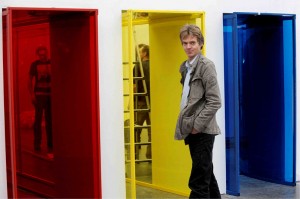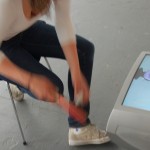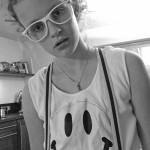Thursday 6th I invited Laura and Laura to come play at Tractie. Shot a lot…
Demarrage three
In 2008 I visited the ‘De Pont” museum in Tilburg to view a solo-exposition of the work of Dutch artist Job Koelewijn. I really do admire his work! I took my younger daughter with me; she was 5 at the time. She was exited about Koelewijn’s ‘Red & Yellow & Blue’, played hopscotch all through the tunnels and talked loudly about the fun she was having. I then was addressed by an elderly lady who asked me to constrain my child, as this was ‘no playground but a museum’. Apparently, art has to be appreciated in contemplative silence. This experience made me think about the role of play and playing in the world of art.
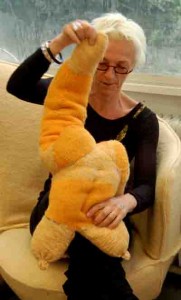
Heleen playing with one of the dolls
So, in my third year at HKU I did some experiments. I made objects that I hoped would be irresistible to touch and play with. I made both geometrical objects and forms relating to the female body, all made out of wool. When lying about in my atelier people did play with them. I noticed that they more often picked up the geometrical objects than the somewhat exaggerated female forms.
When I was asked to participate in a group exhibition ( Demarrage 27.02.09 – 28.03.09) with other students at the Academiegalerie in Utrecht, I had a chance to extend my experiment to a gallery setting. The orange structure jou see standing in the middle of the gallery is mine. It it has no title as yet, is about 1.60 tall and is made of wood, stuffing and wool. It goes from rather hard at the bottom (because of the wool) to very soft and springy at the top (because of the stuffing). The wool wrinkles in an attractive way – I think – and is meant to tempt you to touch the thing. I didn’t want to post a sign telling people that they could touch of play with, that felt like cheating.
Whatever we can think of this thing as a piece of art – and I have my reservations – as an experiment it was very illuminating. Nobobody touched the thing or played with it – at least not at the opening.. I checked with the students who baby-sat the exhibition during the week. Same thing: nobody touches.
By the way, let me give you a couple of names of fellow students that were in the show and whose work inspired me: Geert van Mil, Eva Spierenburg (you see her painting to the right), Jolijn de Wolf and Jasper Griepink.
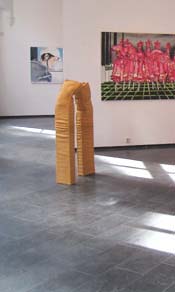
'Demarrage' expo feb 09
This experiment also taught me something about the curator – he just didn’t dig the thing about people being allowed to touch, play and give the thing another shape. I think I may not have explained it clearly, but his conditioning as a guardian of artworks that have been placed just so will also have played a part. I never realised this, but placing stuff in a gallery is serious business! Some of the painters really spent a whole day deciding where on the wall their picture should go. All of this, as I said, was really illuminating.
I add a picture of my family at the Academiegalerie. They played – but then, I asked them to ……
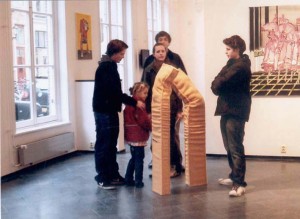
My family at 'Demarrage'
Note: have seen a few interesting examples last week about how people were taken into a work of art. Apparently Rirkrit Tiravanija once copied a room into another room by having someone memorise a description of the first room and then have him/her recite this description to the audience in the second room. Also Felix Gonzalez Torres posted museum assistants next to his mountain of candy explaining the why’s and wherefores of his work.
Note: people saw these forms as a man and a woman having a conversation. Why do we interpret things as male or female forms given the slightest provocation?
Note: I get tired calling the thing the thing. Need to name things in future. If Adam and Eve started out life in Paradise naming things, it cannot be that bad. I will start to address the experiments by their proper names: this is Experiment no 001/2008: Playthings. I changed the title to this blog accordingly.
| « If you don’t document it, it never existed. | <-- previous post | next post --> | Playing with dolls » |
|---|
